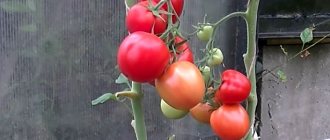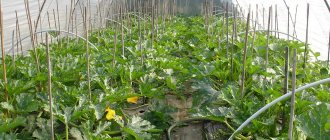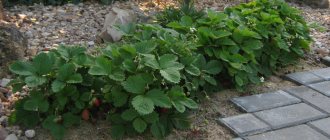Eggplants have long been included in the list of the most popular crops for growing in summer cottages. If ten years ago it was very easy to choose a variety, now it is more problematic. Breeders constantly offer vegetable growers new, improved hybrids and varieties of eggplants that bear fruit well even in the Northern regions.
Eggplant “Nutcracker F1” is worthy of the attention of gardeners. In a very short time, the hybrid gained popularity due to its characteristics. Let's consider the features of growing eggplant seedlings "Nutcracker F1", as well as the agrotechnical requirements of the plant. To do this, let’s get acquainted with the description of the variety and photo of the “Nutcracker F1” eggplant.
Description and characteristics of the variety
- Nutcracker F1 is a hybrid, so seeds for sowing must be purchased every year.
- Early. The first ripe fruits appear 95-110 days after planting the seeds in the ground, 45 days from the moment the seedlings are transplanted to a permanent place.
- Relatively easy to care for when grown in a greenhouse, hotbed or under film cover. Nutcracker eggplants do not feel very comfortable in open ground.
- The bush is semi-spreading and requires at least 1.2 square meters. m. In open ground it grows up to 1 m in height, and in a greenhouse it can stretch up to 1.5 m and higher.
- The leaves are large, round, dark green.
- It forms many ovaries, thanks to which it bears fruit for a long time.
- Productivity is high. From 1 sq. m, up to 20 kg of ripe fruits are collected. One bush produces 5 kg of vegetables, and with proper agricultural technology - up to 8 kg.
Diseases and pests
Eggplants of the Nutcracker F1 variety can be affected by fungal and viral diseases. As with most nightshades, various types of rot and late blight are dangerous for them. The best way to fight is prevention. Compliance with crop rotation, control of light and humidity in the greenhouse, modern weeding, inspection of plants and removal of dry leaves, as well as treatment with fungicides will not allow diseases to develop.
One of the pests that can cause significant damage to Nutcracker F1 eggplants is the Colorado potato beetle. Potatoes should not be planted near the greenhouse. To repel insects, plantings are periodically watered with strong infusions of onion peels or garlic feathers.
Advantages and disadvantages
This hybrid has many advantages, among which are the following:
- High yield.
- Suitable for growing in open and closed ground.
- Great taste, no bitterness.
- Marketable condition.
- Long-term storage.
- Resistance to transportation.
- Versatility of use.
- Long-term fruiting.
- Early ripening.
The disadvantages of the variety include:
- Susceptible to diseases and pest attacks.
However, if you follow all the rules of agricultural technology, this can be avoided and a good harvest of ripe and tasty eggplants can be grown on your plot.
Harvesting and application
Eggplants are harvested when their skin turns a deep purple color and the flesh becomes firm. Do not let the vegetable overripe, as the pulp will become bitter and the skin will become thin. At the same time, eggplants are not able to ripen outside the bush, so it is important not to miss the ideal moment for harvesting. Check vegetables for ripeness every 2-3 days. When cutting an eggplant, leave a stem tail of 3 cm. For long-term storage, wipe the vegetables with a dry cloth and place in a dark and cool place.
Important ! Eggplants cannot be stored for more than two months, so it is better to preserve them immediately. The fruits can also be dried well, then cut and frozen. The product is used in this form throughout the year, defrosted and added to dishes. At the same time, eggplants do not lose their taste and beneficial properties.
The Nutcracker variety is used to prepare a variety of dishes: spicy rolls, the famous fried eggplants with tomatoes, and even juicy lasagna. The neutral taste of the vegetable goes well with most ingredients, and its interesting appearance will decorate any salad or soup. Housewives also like to preserve eggplants for the winter. Especially tasty preparations are obtained with the addition of ginger and a mixture of Provençal herbs.
Interesting ! You can make an original vegetable strudel from eggplant. In addition to this vegetable, you will need phyllo dough, feta cheese, bell pepper, olive oil, zucchini, fresh spinach leaves and egg yolk. The dough is rolled out into thin layers, greased with oil and layered with already baked and diced vegetables, spinach and feta cheese. Everything is wrapped in a roll and brushed with egg yolk. Bake in the oven for about 40 minutes.
Features of cultivation
Nutcracker f1 eggplants can be grown without seedlings only in the south of the country with a warm climate. In other regions, this hybrid must be grown through seedlings.
When to plant eggplant seedlings
The main thing is to correctly calculate the timing of sowing seeds, then the plant will take root well and bring a decent harvest.
When the seedlings are 65 days old, they must be moved to a permanent location. At the same time, bushes can be planted in open ground no earlier than June 15, and in the southern regions and in a greenhouse - after May 15.
Nutcracker eggplants love light and warmth. The air temperature must be at least 20 degrees, otherwise the flowers will not be pollinated and the fruits will not form.
Seeds
For sowing, choose high-quality seed material. To do this, the seeds are soaked in water at room temperature for 3-5 days. Only those that sank to the bottom are kept, and those that float up are thrown away.
The selected material is wrapped in wet gauze, which is constantly moistened until sprouts appear. It can be impregnated with a growth stimulator (Zircon, Epin, potassium humate).
Priming
Next, prepare fertile soil. You can buy it at a garden store or prepare it yourself by mixing humus, turf soil and river sand in a ratio of 4:2:1.
The soil mixture is disinfected by calcining it in the oven, watering it with a solution of potassium permanganate, or freezing it in the cold. This is necessary to protect the seedlings from diseases and pests.
The container is washed with a solution of potassium permanganate and, after drying, the prepared soil is poured into it, while laying a drainage layer on the bottom.
Sowing seeds
The soil is moistened, holes are made and seeds are placed in them at a distance of 1 cm from each other. Everything is covered with soil, watered with warm water from a spray bottle and the containers are covered with transparent material until shoots appear. All this time, planting must be regularly watered and ventilated.
When sprouts appear on the surface, the film is removed and the containers are placed in a bright and warm place. After 7 days (when 1-2 leaves appear), the seedlings are planted in separate cups.
Rules for caring for seedlings:
- Daylight should reach the seedlings for 12-14 hours a day.
- During the day, the air temperature should be kept within 26°C, at night – at least 16°C.
- Seedlings should be watered with settled water at room temperature.
- Fertilizing is carried out 14 days after emergence and immediately after picking.
Top dressing
For fertilizer you can use the following products:
- 30 grams of potassium nitrate are dissolved in 10 liters of water. This is a universal fertilizer for open and closed ground.
- Dissolve 20-30 grams of Kemira-Lux fertilizer in 10 liters of water.
- 5 grams of ammonium nitrate, 10 grams of potassium sulfate and 15 grams of superphosphate are dissolved in 10 liters of water.
Transplanting seedlings
When the seedlings grow to 15 cm and already have 6 leaves, they are transferred to a permanent place.
The eggplant bed is prepared in advance. The soil is dug up and fertilized in the fall. In the spring it is loosened. In the greenhouse, the soil is additionally treated with a hot solution of manganese. 2 weeks before transplanting, add wood ash to the soil. Dig holes at intervals of 60 cm from each other.
Advice! In the greenhouse, the bushes are planted in a checkerboard pattern.
Before planting, the seedlings are well watered and, together with a lump of earth, transferred to the holes, deepened to the cotyledon leaves. Next, the plantings are filled in, the soil is compacted, watered and mulched with humus.
For more information on how to grow eggplant seedlings, read the article: When and how to plant eggplant seedlings: step-by-step instructions
Further care
Caring for the Nutcracker variety means timely watering, weeding the beds and applying fertilizers. Water the beds every five days, and the soil should always be slightly moist. If the plant grows in a greenhouse, the soil is moistened once every two weeks. It is best to water after loosening - this way the water will get to the roots faster. One bush consumes 2-4 liters of water.
Another important stage of care is weeding, which includes removing weeds and loosening. Weeds take away some of the nutrients from the crop and impede access to sunlight. In addition, they are often the cause of diseases affecting vegetables. Loosening is necessary in order to provide oxygen access to the roots and make the soil lighter.
During the entire ripening period, it is recommended to feed eggplants three times. The first fertilizer is applied 2-3 weeks after transplantation (for example, potassium chloride or ammonium nitrate). The Nutcracker is fed the second time after the formation of fruits on the lateral shoots. Liquid chicken manure is recognized as an effective fertilizer. The third time the crop is fertilized two weeks before harvesting.
Important ! During fruiting, feed the plant with bird droppings and Nitrophoska. After infusing the mixture, it is recommended to water the eggplants at the rate of 1.5 liters of solution per bush. This method improves the taste of vegetables and increases yield.
Features of cultivation and possible difficulties
When growing the Nutcracker variety, gardeners are advised to pay attention to some nuances, which will help avoid difficulties and increase productivity:
- water the plant only in the evening so that the moisture does not evaporate in the sun, but goes directly into the soil;
- When growing vegetables in a greenhouse, constantly ventilate it;
- do not forget to periodically mulch the beds.
Particular attention is paid to the formation of the bush. When the plant reaches 30 cm, pinch off the top, leaving two vegetables on the side shoots. When the stepsons begin to branch, leave one, the most powerful one, and pinch the rest. If this is not done, many unnecessary shoots will form, which will take strength from the fruits that have not yet formed.
Also, eggplants are especially sensitive to a lack of microelements, so it is recommended to feed the plant once with the “Riga mixture”: one tablet is diluted in 10 liters of water and the beds are watered.
Diseases and pests
All diseases of the variety can be divided into viral, fungal and bacterial. Fungi include late blight, white and black leg, and root rot. Fungus appears due to improper care and high humidity. Fungal spores penetrate the stem through the stomata and are spread throughout the plant with water. It is recommended to fight diseases with the help of professional drugs, such as Quadris, Fitosporin, HOM.
Viral diseases include tobacco mosaic and phytoplasmosis. Because of them, the fruits become deformed and the leaves acquire a brownish-gray tint. It is almost impossible to cure a plant from such diseases, so it is necessary to carry out prevention using the products “Aktara” and “Condifor”.
Bacterial diseases appear due to low temperatures and high humidity. Bacterial blotch causes watery spots on eggplants and leaves the leaves dry and black. If the bush has already become infected with spotting, it is immediately removed and burned.
Important ! The most important pest of eggplants is the Colorado potato beetle. They destroy it in several ways: manually collect it from the bushes and burn it, or use special preparations (“Colorado”, “Bikol”). The mass appearance of the Colorado potato beetle occurs during the flowering period of the bushes. Eggplants are also attacked by whiteflies and aphids, which a soap solution helps fight.
Planting seedlings in open ground
Eggplants are transplanted into open ground closer to mid-May. The weather should be warm outside.
The process of planting seedlings:
- dig up the soil, remove weeds;
- add manure and dig up the soil again;
- leave the soil for 2 weeks;
- after 2 weeks they begin to plant seedlings;
- make holes in the soil 30 cm deep;
- the distance between the holes is left 60 cm;
- Place the seedling in the hole and bury it with soil.
Water the garden bed generously. In the evening, cover the beds with a warm cloth. It is advisable to cover eggplants for the first two weeks.
History of the variety's creation
The Nutcracker F1 eggplant was bred by breeders from an agricultural plant located in the Moscow region in the last quarter of the last century. This eggplant was introduced to the Russian State Register in 1998.
After variety testing in 2001, this hybrid was included in the State Register.
The originators recommended planting this hybrid in heated and unheated greenhouses in light zones 1 and 3 of the country. This vegetable plant can be planted in garden beds only in the south of the country, because good yields from eggplants are obtained in regions with a sufficient number of sunny days, and the air temperature should be above 17 degrees Celsius.
Photo of eggplant Nutcracker F1
Advantages and disadvantages
Advantages of the breed:
- a small dog that is easy to keep in an apartment or room;
- despite their small stature, they are in good health;
- feeding them will not require much expenditure - they eat little;
- loyal to the owner, will always come to his defense;
- loud barking will warn of intruders;
- if it is not possible to walk the dog, then it can go to a special tray;
- has a cute appearance that many people like;
- It’s easy to move with a toy terrier when moving or traveling;
- Dogs have developed empathy - they feel the mood of the owner.
Minuses:
- with a lack of upbringing they can be aggressive and uncontrollable;
- do not like training, although they are quite smart;
- prone to food allergies;
- have brittle bones, which is why you need to be careful when walking;
- do not get along well with children and may snap or bite;
- They treat all strangers with distrust and may not even accept a family member;
- cannot stand loneliness; against this background, mental instability may develop.
Reviews from gardeners about the Nutcracker F1 variety
The variety is more interesting for commercial cultivation, but the average summer resident can also get a good harvest of quality products. However, you should not try to grow Nutcracker eggplant in an open garden bed in climates with cold summers. Of course, cultivating greenhouse varieties is somewhat more difficult, but in comparison with a number of other hybrids intended for protected soil, growing this eggplant does not require too much labor.
- Author: Zaplavskaya Tamara
I have several professions in different fields, including a musician and an accountant. Higher education. Rate this article: (1 vote, average: 5 out of 5)
Reviews from those who planted
Below you can study reviews from Russian gardeners who have ever grown this hybrid on their plots in open or closed ground. Based on them, you will be able to draw certain conclusions and decide whether it is worth growing these vegetables on your plot.
Dmitry Alexandrovich, Tver region
Margarina Vladimirovna, Sverdlovsk region
Irina Sergeevna, Voronezh region
Viktor Pavlovich, Belgorod region
Natalya Nikolaevna, Lipetsk region
Svetlana Petrovna, Omsk region
Tatyana Sergeevna, Moscow region
Rosa Eduardovna, Samara region
Description of the breed
In Russia, this breed began to be bred literally from scratch, so it differs in many ways from its English counterpart. This mainly concerns the exterior - the Russian toy has acquired fringe on its paws and ears.
The height of such a dog is 28-30 cm, and weigh no more than 3 kg. It is much smaller than the English breed. Also, the Russian Toy has long fur and feathers. Short-haired representatives have fur that does not have an undercoat; it lies tightly to the body.
NOTE!
The differences between English and Russian Toys are due to the strict selection that took place in Russia when breeding this breed.
Representatives of this breed have a lean body, large triangular ears, a pointed muzzle and a long tail. They also have thin and long limbs. Animals move easily and gracefully.
Read more about what toy terriers look like here.
Russian Toy Terriers come in the following colors:
- black and tan;
- brown and tan;
- blue and tan;
- lilac and tan;
- plain red and black.
Features of plant care
The culture is quite demanding in terms of growing conditions, but the Nutcracker among its fellows is considered relatively unpretentious. A good harvest can be obtained by following the standard agricultural practices for eggplants.
Shaping and garter
Hybrid bushes grow quite tall, so they require shaping and staking. To tie up the plants, crossbars are installed under the ceiling of the greenhouse and long cords are attached to them, which are used to twist the stems as they grow.
When grown in cramped conditions, plants can be formed into 1 stem. From the main shoot to a height of 45–50 cm, all lateral branches are removed to the growth point. In the next three nodes, 1–2 ovaries are left, and the shoots are pinched. Then, when pinching the shoots, first one leaf with an ovary is left on them, then two or three, and so on. To form bushes with 2 or 3 stems, pinch the top at a height of 30–35 cm, select the strongest branches and form them according to the same principle. In order for the ovaries to develop better, remove the leaves that shade them and free the lower part of the stem from vegetation.
If there is not enough space, eggplant bushes are formed into 1 stem
Watering and fertilizing
Eggplants are moisture-loving; indoors they are watered 1-2 times a week, on hot days - every other day. Since the optimal air humidity for the crop is 60%, and for the soil - 75–80%, it is better to water the plants at the root. The ideal option would be to organize a drip irrigation system.
Drip watering of eggplants will help balance the level of air and soil humidity
Nutcracker is a productive variety with an extended fruiting period, so the plants need to be provided with a sufficient amount of nutrients. It is best to use complex fertilizing, but it must be taken into account that the hybrid, like other eggplants, primarily needs nitrogen at the beginning of growth. During the period of ovary formation and fruiting, there is an increased need for phosphorus and potassium.
Productivity
Fruiting of this variety is extended over time, since the ovaries form on the bushes gradually - first in the lower part, then on the upper parts of the shoots.
Approximately 5 kg of ripe produce is harvested from one plant per season.
, if you follow all the rules of care and apply fertilizing in a timely manner, then the yield of Nutcracker eggplant can increase to 7-8 kg per bush.
No more than 4 plants are planted on each square of area, so at least 20 kg of eggplants are collected from 1 m2.











